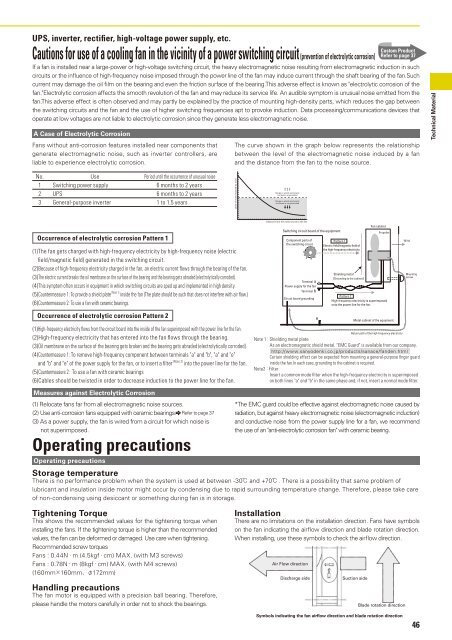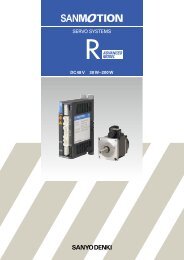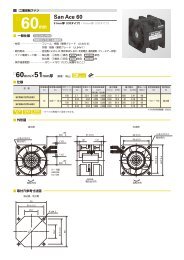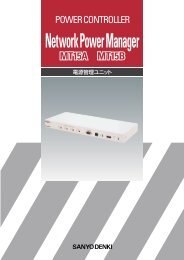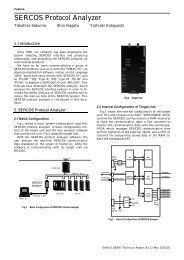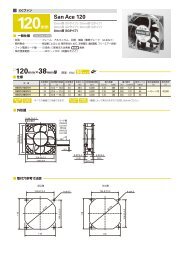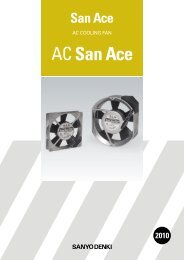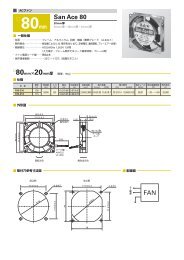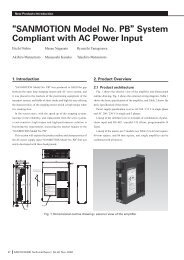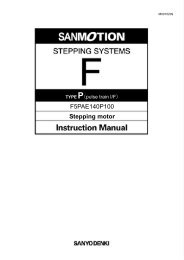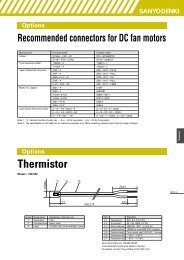Technical Information AC fan - SANYO DENKI Global
Technical Information AC fan - SANYO DENKI Global
Technical Information AC fan - SANYO DENKI Global
You also want an ePaper? Increase the reach of your titles
YUMPU automatically turns print PDFs into web optimized ePapers that Google loves.
UPS, inverter, rectifier, high-voltage power supply, etc.Cautions for use of a cooling <strong>fan</strong> in the vicinity of a power switching circuit (prevention of electrolytic corrosion)If a <strong>fan</strong> is installed near a large-power or high-voltage switching circuit, the heavy electromagnetic noise resulting from electromagnetic induction in suchcircuits or the influence of high-frequency noise imposed through the power line of the <strong>fan</strong> may induce current through the shaft bearing of the <strong>fan</strong>.Suchcurrent may damage the oil film on the bearing and even the friction surface of the bearing.This adverse effect is known as "electrolytic corrosion of the<strong>fan</strong>."Electrolytic corrosion affects the smooth revolution of the <strong>fan</strong> and may reduce its service life. An audible symptom is unusual noise emitted from the<strong>fan</strong>.This adverse effect is often observed and may partly be explained by the practice of mounting high-density parts, which reduces the gap betweenthe switching circuits and the <strong>fan</strong> and the use of higher switching frequencies apt to provoke induction. Data processing/communications devices thatoperate at low voltages are not liable to electrolytic corrosion since they generate less electromagnetic noise.A Case of Electrolytic CorrosionFans without anti-corrosion features installed near components thatgenerate electromagnetic noise, such as inverter controllers, areliable to experience electrolytic corrosion.Custom ProductRefer to page 37The curve shown in the graph below represents the relationshipbetween the level of the electromagnetic noise induced by a <strong>fan</strong>and the distance from the <strong>fan</strong> to the noise source.<strong>Technical</strong> MaterialNo. Use Period until the occurrence of unusual noise1 Switching power supply 6 months to 2 years2 UPS 6 months to 2 years3 General-purpose inverter 1 to 1.5 yearsLevel of noise induced by a <strong>fan</strong>Range in which electrolyticcorrosion is generatedRange in which electrolyticcorrosion is not generatedOccurrence of electrolytic corrosion Pattern 1(1)The <strong>fan</strong> gets charged with high-frequency electricity by high-frequency noise (electricfi eld/magnetic fi eld) generated in the switching circuit.(2)Because of high-frequency electricity charged in the <strong>fan</strong>, an electric current fl ows through the bearing of the <strong>fan</strong>.(3)The electric current breaks the oil membrane on the surface of the bearing and the bearing gets abraded (electrolytically corroded).(4)This symptom often occurs in equipment in which switching circuits are sped up and implemented in high density.(5)Countermeasure 1: To provide a shield plate (Note 1) inside the <strong>fan</strong> (The plate should be such that does not interfere with air flow.)(6)Countermeasure 2: To use a <strong>fan</strong> with ceramic bearings.Occurrence of electrolytic corrosion Pattern 2(1)High-frequency electricity fl ows from the circuit board into the inside of the <strong>fan</strong> superimposed with the power line for the <strong>fan</strong>.(2)High-frequency electricity that has entered into the <strong>fan</strong> fl ows through the bearing.(3)Oil membrane on the surface of the bearing gets broken and the bearing gets abraded (electrolytically corroded).(4)Countermeasure 1: To remove high-frequency component between terminals "a" and "b", "a" and "e"and "b" and "e" of the power supply for the <strong>fan</strong>, or to insert a fi lter (Note 2) into the power line for the <strong>fan</strong>.(5)Countermeasure 2: To use a <strong>fan</strong> with ceramic bearings(6)Cables should be twisted in order to decrease induction to the power line for the <strong>fan</strong>.Measures against Electrolytic Corrosion(1) Relocate <strong>fan</strong>s far from all electromagnetic noise sources.(2) Use anti-corrosion <strong>fan</strong>s equipped with ceramic bearings. Refer to page 37(3) As a power supply, the <strong>fan</strong> is wired from a circuit for which noise isnot superimposed.Operating precautionsOperating precautionsDistance from the noise source to the <strong>fan</strong>Switching circuit board of the equipmentComponent parts ofthe switching circuitTerminal aPower supply for the <strong>fan</strong>Terminal bCircuit board grounding*The EMC guard could be effective against electromagnetic noise caused byradiation, but against heavy electromagnetic noise (electromagnetic induction)and conductive noise from the power supply line for a <strong>fan</strong>, we recommendthe use of an "anti-electrolytic corrosion <strong>fan</strong>" with ceramic bearing.Storage temperatureThere is no performance problem when the system is used at between -30 and +70 . There is a possibility that same problem oflubricant and insulation inside motor might occur by condensing due to rapid surrounding temperature change. Therefore, please take careof non-condensing using desiccant or something during <strong>fan</strong> is in storage.ePattern 1Electric field/magnetic field ofthe high-frequency electricityShielding metalGrounding to the cabinetFan cabinetPropellerPattern 2High-frequency electricity is superimposedonto the power line for the <strong>fan</strong>.Metal cabinet of the equipmentReturn path of the high-frequency electricityWindMountingscrewNote 1Shielding metal plateAs an electromagnetic shield metal, "EMC Guard" is available from our company.http://www.sanyodenki.co.jp/products/sanace/<strong>fan</strong>den.htmlCertain shielding effect can be expected from mounting a general-purpose fi nger guardinside the <strong>fan</strong>.In each case, grounding to the cabinet is required.Note2FilterInsert a common mode fi lter when the high-frequency electricity is superimposedon both lines "a" and "b" in the same phase and, if not, insert a normal mode fi lter.Tightening TorqueThis shows the recommended values for the tightening torque wheninstalling the <strong>fan</strong>s. If the tightening torque is higher than the recommendedvalues, the <strong>fan</strong> can be deformed or damaged. Use care when tightening.Recommended screw torquesFans : 0.44Nm (4.5kgfcm) MAX. (with M3 screws)Fans : 0.78Nm (8kgfcm) MAX. (with M4 screws)(160mm160mm172mm)Handling precautionsThe <strong>fan</strong> motor is equipped with a precision ball bearing. Therefore,please handle the motors carefully in order not to shock the bearings.InstallationThere are no limitations on the installation direction. Fans have symbolson the <strong>fan</strong> indicating the airflow direction and blade rotation direction.When installing, use these symbols to check the airflow direction.Air Flow directionDischarge sideSuction sideBlade rotation directionSymbols indicating the <strong>fan</strong> airflow direction and blade rotation direction46


